Optimizing Cardiomyocyte Differentiation: Comparative Analysis of Bone Marrow and Adipose-Derived Mesenchymal Stem Cells in Rats Using 5-Azacytidine and Low-Dose FGF and IGF Treatment
Abstract
:1. Introduction
2. Materials and Methods
2.1. Study Design
2.2. Isolation of MSCs from Bone Marrow
2.3. Isolation of MSCs from Adipose Tissue
2.4. Cell Cultivation
2.5. Morphology and Immunophenotyping
2.6. Tri-Lineage Differentiation
2.6.1. Adipogenic Differentiation
2.6.2. Chondrogenic Differentiation
2.6.3. Osteogenic Differentiation
2.7. Gene Expression of MSCs by Reverse-Transcriptase PCR
2.8. Cardiomyogenic Differentiation of BM-MSCs and AD-MSCs
2.9. Morphological Analysis after Differentiation
2.10. Live/Dead Cell Staining
2.11. Quantitative Assessment of the Cardiac-Specific Genes Using RT-qPCR
2.12. Immunofluorescence Staining of Cardiomyocyte-Specific Proteins
2.13. Statistical Analysis
3. Results
3.1. Isolation and Expansion of MSCs
3.1.1. BM-MSCs
3.1.2. AD-MSCs
3.2. Surface Marker Expression of MSCs
3.3. Differentiation Potential of MSCs
3.4. Pluripotency and Immunomodulatory Genes
3.5. Morphological Alterations
3.6. Cell Viability
3.7. Expression of Cardiac-Specific Genes
3.8. Expression of Cardiomyocyte-Specific Proteins
4. Discussion
Limitations
5. Conclusions
Author Contributions
Funding
Institutional Review Board Statement
Informed Consent Statement
Data Availability Statement
Acknowledgments
Conflicts of Interest
References
- Farag, A.; Mandour, A.S.; Hendawy, H.; Elhaieg, A.; Elfadadny, A.; Tanaka, R. A Review on Experimental Surgical Models and Anesthetic Protocols of Heart Failure in Rats. Front. Vet. Sci. 2023, 10, 386. [Google Scholar] [CrossRef]
- Farag, A.; Mandour, A.S.; Hamabe, L.; Yoshida, T.; Shimada, K.; Tanaka, R. Novel Protocol to Establish the Myocardial Infarction Model in Rats Using a Combination of Medetomidine-Midazolam-Butorphanol (MMB) and Atipamezole. Front. Vet. Sci. 2022, 9, 1064836. [Google Scholar] [CrossRef] [PubMed]
- Elhaieg, A.; Farag, A.; Elfadadny, A.; Yokoi, A.; Hendawy, H.; Mandour, A.S.; Tanaka, R. Effect of Experimental Periodontitis on Cardiac Functions: A Comprehensive Study Using Echocardiography, Hemodynamic Analysis, and Histopathological Evaluation in a Rat Model. Front. Vet. Sci. 2023, 10, 1327484. [Google Scholar] [CrossRef] [PubMed]
- Farag, A.; Mandour, A.S.; Kaneda, M.; Elfadadny, A.; Elhaieg, A.; Shimada, K.; Tanaka, R. Effect of Trehalose on Heart Functions in Rats Model after Myocardial Infarction: Assessment of Novel Intraventricular Pressure and Heart Rate Variability. Front. Cardiovasc. Med. 2023, 10, 1182628. [Google Scholar] [CrossRef]
- Farag, A.; Elfadadny, A.; Mandour, A.S.; Ngeun, S.K.; Aboubakr, M.; Kaneda, M.; Tanaka, R. Potential Protective Effects of L-Carnitine against Myocardial Ischemia/Reperfusion Injury in a Rat Model. Environ. Sci. Pollut. Res. 2024, 31, 18813–18825. [Google Scholar] [CrossRef]
- Jagannathan, R.; Patel, S.A.; Ali, M.K.; Narayan, K.M.V. Global Updates on Cardiovascular Disease Mortality Trends and Attribution of Traditional Risk Factors. Curr. Diab. Rep. 2019, 19, 44. [Google Scholar] [CrossRef] [PubMed]
- Saravanan, R.; Kavitha, G.; Serge, O.; Haiguang, Z.; Qingxi, H.; Gulden, C.-U.; Verma, R.S.; Murugan, R. Correction to: Cardiac Differentiation of Mesenchymal Stem Cells: Impact of Biological and Chemical Inducers. Stem Cell Rev. Rep. 2021, 17, 1515. [Google Scholar]
- Varderidou-Minasian, S.; Lorenowicz, M.J. Mesenchymal Stromal/Stem Cell-Derived Extracellular Vesicles in Tissue Repair: Challenges and Opportunities. Theranostics 2020, 10, 5979. [Google Scholar] [CrossRef]
- Golpanian, S.; Wolf, A.; Hatzistergos, K.E.; Hare, J.M. Rebuilding the Damaged Heart: Mesenchymal Stem Cells, Cell-Based Therapy, and Engineered Heart Tissue. Physiol. Rev. 2016, 96, 1127–1168. [Google Scholar] [CrossRef]
- Lan, H.; Xue, Q.; Liu, Y.; Jin, K.; Fang, X.; Shao, H. The Emerging Therapeutic Role of Mesenchymal Stem Cells in Anthracycline-Induced Cardiotoxicity. Cell Tissue Res. 2021, 384, 1–12. [Google Scholar] [CrossRef]
- Fukuda, K. Use of Adult Marrow Mesenchymal Stem Cells for Regeneration of Cardiomyocytes. Bone Marrow Transplant. 2003, 32, S25–S27. [Google Scholar] [CrossRef]
- Malliaras, K.; Marban, E. Cardiac Cell Therapy: Where We’ve Been, Where We Are, and Where We Should Be Headed. Br. Med. Bull. 2011, 98, 161–185. [Google Scholar] [CrossRef] [PubMed]
- Gupta, S.; Sharma, A.; Verma, R.S. Mesenchymal Stem Cells for Cardiac Regeneration: From Differentiation to Cell Delivery. Stem Cell Rev. Rep. 2021, 17, 1666–1694. [Google Scholar] [CrossRef] [PubMed]
- Yang, G.; Xiao, Z.; Ren, X.; Long, H.; Ma, K.; Qian, H.; Guo, Y. Obtaining Spontaneously Beating Cardiomyocyte-like Cells from Adipose-Derived Stromal Vascular Fractions Cultured on Enzyme-Crosslinked Gelatin Hydrogels. Sci. Rep. 2017, 7, 41781. [Google Scholar] [CrossRef] [PubMed]
- Puissant, B.; Barreau, C.; Bourin, P.; Clavel, C.; Corre, J.; Bousquet, C.; Taureau, C.; Cousin, B.; Abbal, M.; Laharrague, P. Immunomodulatory Effect of Human Adipose Tissue-derived Adult Stem Cells: Comparison with Bone Marrow Mesenchymal Stem Cells. Br. J. Haematol. 2005, 129, 118–129. [Google Scholar] [CrossRef] [PubMed]
- Choudhery, M.S.; Badowski, M.; Muise, A.; Pierce, J.; Harris, D.T. Subcutaneous Adipose Tissue–Derived Stem Cell Utility Is Independent of Anatomical Harvest Site. Biores. Open Access 2015, 4, 131–145. [Google Scholar] [CrossRef] [PubMed]
- Malandraki-Miller, S.; Lopez, C.A.; Al-Siddiqi, H.; Carr, C.A. Changing Metabolism in Differentiating Cardiac Progenitor Cells—Can Stem Cells Become Metabolically Flexible Cardiomyocytes? Front. Cardiovasc. Med. 2018, 5, 119. [Google Scholar] [CrossRef]
- Fenaux, P.; Mufti, G.J.; Hellström-Lindberg, E.; Santini, V.; Gattermann, N.; Germing, U.; Sanz, G.; List, A.F.; Gore, S.; Seymour, J.F. Azacitidine Prolongs Overall Survival Compared with Conventional Care Regimens in Elderly Patients with Low Bone Marrow Blast Count Acute Myeloid Leukemia. J. Clin. Oncol. 2010, 28, 562–569. [Google Scholar] [CrossRef]
- Wan Safwani, W.K.Z.; Makpol, S.; Sathapan, S.; Chua, K.H. 5-Azacytidine Is Insufficient for Cardiogenesis in Human Adipose-Derived Stem Cells. J. Negat. Results Biomed. 2012, 11, 3. [Google Scholar] [CrossRef]
- Zhou, G.-S.; Zhang, X.-L.; Wu, J.-P.; Zhang, R.-P.; Xiang, L.-X.; Dai, L.-C.; Shao, J.-Z. 5-Azacytidine Facilitates Osteogenic Gene Expression and Differentiation of Mesenchymal Stem Cells by Alteration in DNA Methylation. Cytotechnology 2009, 60, 11–22. [Google Scholar] [CrossRef]
- Guo, X.; Bai, Y.; Zhang, L.; Zhang, B.; Zagidullin, N.; Carvalho, K.; Du, Z.; Cai, B. Cardiomyocyte Differentiation of Mesenchymal Stem Cells from Bone Marrow: New Regulators and Its Implications. Stem Cell Res. Ther. 2018, 9, 44. [Google Scholar] [CrossRef] [PubMed]
- Sugi, Y.; Sasse, J.; Barron, M.; Lough, J. Developmental Expression of Fibroblast Growth Factor Receptor-1 (Cek-1; Flg) during Heart Development. Dev. Dyn. 1995, 202, 115–125. [Google Scholar] [CrossRef] [PubMed]
- Khezri, S.; Valojerdi, M.R.; Sepehri, H.; Baharvand, H. Effect of Basic Fibroblast Growth Factor on Cardiomyocyte Differentiation from Mouse Embryonic Stem Cells. Saudi Med. J. 2007, 28, 181. [Google Scholar]
- Suleiman, M.-S.; Singh, R.J.R.; Stewart, C.E.H. Apoptosis and the Cardiac Action of Insulin-like Growth Factor I. Pharmacol. Ther. 2007, 114, 278–294. [Google Scholar] [CrossRef] [PubMed]
- Javazon, E.H.; Colter, D.C.; Schwarz, E.J.; Prockop, D.J. Rat Marrow Stromal Cells Are More Sensitive to Plating Density and Expand More Rapidly from Single-Cell-Derived Colonies than Human Marrow Stromal Cells. Stem Cells 2001, 19, 219–225. [Google Scholar] [CrossRef]
- Lotfy, A.; Salama, M.; Zahran, F.; Jones, E.; Badawy, A.; Sobh, M. Characterization of Mesenchymal Stem Cells Derived from Rat Bone Marrow and Adipose Tissue: A Comparative Study. Int. J. Stem Cells 2014, 7, 135–142. [Google Scholar] [CrossRef]
- Koung Ngeun, S.; Shimizu, M.; Kaneda, M. Myogenic Differentiation and Immunomodulatory Properties of Rat Adipose-Derived Mesenchymal Stem/Stromal Cells. Biology 2024, 13, 72. [Google Scholar] [CrossRef]
- Hendawy, H.; Kaneda, M.; Metwally, E.; Shimada, K.; Tanaka, T.; Tanaka, R. A Comparative Study of the Effect of Anatomical Site on Multiple Differentiation of Adipose-Derived Stem Cells in Rats. Cells 2021, 10, 2469. [Google Scholar] [CrossRef]
- Guo, Y.; Zhang, X.; Zhang, C.; Li, R.; Zeng, Q.; Guo, C.; Zhang, Y. Effects of Mechanical Stimulus on Mesenchymal Stem Cells Differentiation toward Cardiomyocytes. Asian Biomed. 2011, 5, 655–661. [Google Scholar]
- Xinyun, C.; Zhi, Z.; Bin, Z.; Li, R.; Yucheng, C.; Yafei, Y.; Tingjie, Z.; Shengfu, L. Effects of Cardiotrophin-1 on Differentiation and Maturation of Rat Bone Marrow Mesenchymal Stem Cells Induced with 5-Azacytidine in Vitro. Int. J. Cardiol. 2010, 143, 171–177. [Google Scholar] [CrossRef]
- Kawai, T.; Takahashi, T.; Esaki, M.; Ushikoshi, H.; Nagano, S.; Fujiwara, H.; Kosai, K. Efficient Cardiomyogenic Differentiation of Embryonic Stem Cell by Fibroblast Growth Factor 2 and Bone Morphogenetic Protein 2. Circ. J. 2004, 68, 691–702. [Google Scholar] [CrossRef] [PubMed]
- Shuang, T.; Fu, M.; Yang, G.; Wu, L.; Wang, R. The Interaction of IGF-1/IGF-1R and Hydrogen Sulfide on the Proliferation of Mouse Primary Vascular Smooth Muscle Cells. Biochem. Pharmacol. 2018, 149, 143–152. [Google Scholar] [CrossRef] [PubMed]
- Gong, H.; Wang, X.; Wang, L.; Liu, Y.; Wang, J.; Lv, Q.; Pang, H.; Zhang, Q.; Wang, Z. Inhibition of IGF-1 Receptor Kinase Blocks the Differentiation into Cardiomyocyte-like Cells of BMSCs Induced by IGF-1. Mol. Med. Rep. 2017, 16, 787–793. [Google Scholar] [CrossRef]
- Zhu, Y.; Ouyang, Y.; Chang, Y.; Luo, C.; Xu, J.; Zhang, C.; Huang, W. Evaluation of the Proliferation and Differentiation Behaviors of Mesenchymal Stem Cells with Partially Converted Borate Glass Containing Different Amounts of Strontium in Vitro. Mol. Med. Rep. 2013, 7, 1129–1136. [Google Scholar] [CrossRef] [PubMed]
- Liu, B.-H.; Yeh, H.-Y.; Lin, Y.-C.; Wang, M.-H.; Chen, D.C.; Lee, B.-H.; Hsu, S. Spheroid Formation and Enhanced Cardiomyogenic Potential of Adipose-Derived Stem Cells Grown on Chitosan. Biores. Open Access 2013, 2, 28–39. [Google Scholar] [CrossRef]
- Yi, Q.; Xu, H.; Yang, K.; Wang, Y.; Tan, B.; Tian, J.; Zhu, J. Islet-1 Induces the Differentiation of Mesenchymal Stem Cells into Cardiomyocyte-like Cells through the Regulation of Gcn5 and DNMT-1. Mol. Med. Rep. 2017, 15, 2511–2520. [Google Scholar] [CrossRef]
- Grafton, F.; Ho, J.; Ranjbarvaziri, S.; Farshidfar, F.; Budan, A.; Steltzer, S.; Maddah, M.; Loewke, K.E.; Green, K.; Patel, S. Deep Learning Detects Cardiotoxicity in a High-Content Screen with Induced Pluripotent Stem Cell-Derived Cardiomyocytes. eLife 2021, 10, e68714. [Google Scholar] [CrossRef]
- Zhang, J.; Ho, J.C.; Chan, Y.; Lian, Q.; Siu, C.; Tse, H. Overexpression of Myocardin Induces Partial Transdifferentiation of Human-induced Pluripotent Stem Cell-derived Mesenchymal Stem Cells into Cardiomyocytes. Physiol. Rep. 2014, 2, e00237. [Google Scholar] [CrossRef]
- Hao, W.; Shi, S.; Zhou, S.; Wang, X.; Nie, S. Aspirin Inhibits Growth and Enhances Cardiomyocyte Differentiation of Bone Marrow Mesenchymal Stem Cells. Eur. J. Pharmacol. 2018, 827, 198–207. [Google Scholar] [CrossRef]
- Ullah, I.; Subbarao, R.B.; Rho, G.J. Human Mesenchymal Stem Cells-Current Trends and Future Prospective. Biosci. Rep. 2015, 35, e00191. [Google Scholar] [CrossRef]
- Pittenger, M.F.; Martin, B.J. Mesenchymal Stem Cells and Their Potential as Cardiac Therapeutics. Circ. Res. 2004, 95, 9–20. [Google Scholar] [CrossRef]
- Li, T.-S.; Hayashi, M.; Ito, H.; Furutani, A.; Murata, T.; Matsuzaki, M.; Hamano, K. Regeneration of Infarcted Myocardium by Intramyocardial Implantation of Ex Vivo Transforming Growth Factor-β–Preprogrammed Bone Marrow Stem Cells. Circulation 2005, 111, 2438–2445. [Google Scholar] [CrossRef]
- Kakkar, A.; Nandy, S.B.; Gupta, S.; Bharagava, B.; Airan, B.; Mohanty, S. Adipose Tissue Derived Mesenchymal Stem Cells Are Better Respondents to TGFβ1 for in Vitro Generation of Cardiomyocyte-like Cells. Mol. Cell. Biochem. 2019, 460, 53–66. [Google Scholar] [CrossRef]
- Koung Ngeun, S.; Shimizu, M.; Kaneda, M. Characterization of Rabbit Mesenchymal Stem/Stromal Cells after Cryopreservation. Biology 2023, 12, 1312. [Google Scholar] [CrossRef] [PubMed]
- Nadri, S.; Soleimani, M. Isolation Murine Mesenchymal Stem Cells by Positive Selection. In Vitro Cell. Dev. Biol. 2007, 43, 276–282. [Google Scholar] [CrossRef] [PubMed]
- Zhu, Y.; Liu, T.; Song, K.; Fan, X.; Ma, X.; Cui, Z. Adipose-derived Stem Cell: A Better Stem Cell than BMSC. Cell Biochem. Funct. Cell. Biochem. Its Modul. Act. Agents Dis. 2008, 26, 664–675. [Google Scholar]
- Sun, C.-K.; Yen, C.-H.; Lin, Y.-C.; Tsai, T.-H.; Chang, L.-T.; Kao, Y.-H.; Chua, S.; Fu, M.; Ko, S.-F.; Leu, S. Autologous Transplantation of Adipose-Derived Mesenchymal Stem Cells Markedly Reduced Acute Ischemia-Reperfusion Lung Injury in a Rodent Model. J. Transl. Med. 2011, 9, 118. [Google Scholar] [CrossRef]
- Asumda, F.Z.; Chase, P.B. Age-Related Changes in Rat Bone-Marrow Mesenchymal Stem Cell Plasticity. BMC Cell Biol. 2011, 12, 44. [Google Scholar] [CrossRef]
- Yang, J.; Song, T.; Wu, P.; Chen, Y.; Fan, X.; Chen, H.; Zhang, J.; Huang, C. Differentiation Potential of Human Mesenchymal Stem Cells Derived from Adipose Tissue and Bone Marrow to Sinus Node-like Cells. Mol. Med. Rep. 2012, 5, 108–113. [Google Scholar]
- Yoshimura, H.; Muneta, T.; Nimura, A.; Yokoyama, A.; Koga, H.; Sekiya, I. Comparison of Rat Mesenchymal Stem Cells Derived from Bone Marrow, Synovium, Periosteum, Adipose Tissue, and Muscle. Cell Tissue Res. 2007, 327, 449–462. [Google Scholar] [CrossRef]
- Chambers, I.; Tomlinson, S.R. The Transcriptional Foundation of Pluripotency. Development 2009, 136, 2311–2322. [Google Scholar] [CrossRef]
- Silva, J.; Smith, A. Capturing Pluripotency. Cell 2008, 132, 532–536. [Google Scholar] [CrossRef] [PubMed]
- Scotland, K.B.; Chen, S.; Sylvester, R.; Gudas, L.J. Analysis of Rex1 (Zfp42) Function in Embryonic Stem Cell Differentiation. Dev. Dyn. 2009, 238, 1863–1877. [Google Scholar] [CrossRef] [PubMed]
- Pierantozzi, E.; Gava, B.; Manini, I.; Roviello, F.; Marotta, G.; Chiavarelli, M.; Sorrentino, V. Pluripotency Regulators in Human Mesenchymal Stem Cells: Expression of NANOG but Not of OCT-4 and SOX-2. Stem Cells Dev. 2011, 20, 915–923. [Google Scholar] [CrossRef] [PubMed]
- Karaöz, E.; Okçu, A.; Gacar, G.; Sağlam, Ö.; Yürüker, S.; Kenar, H. A Comprehensive Characterization Study of Human Bone Marrow Mscs with an Emphasis on Molecular and Ultrastructural Properties. J. Cell. Physiol. 2011, 226, 1367–1382. [Google Scholar] [CrossRef]
- Greco, S.J.; Liu, K.; Rameshwar, P. Functional Similarities among Genes Regulated by OCT4 in Human Mesenchymal and Embryonic Stem Cells. Stem Cells 2007, 25, 3143–3154. [Google Scholar] [CrossRef]
- Casella, S. Gene Expression Analysis of Rat Adi-Pose Tissue-Derived Stem Cells. Int. J. Stem Cell Res. Transpl. 2015, 3, 120–124. [Google Scholar]
- Parsons, X.H. Embedding the Future of Regenerative Medicine into the Open Epigenomic Landscape of Pluripotent Human Embryonic Stem Cells. Annu. Res. Rev. Biol. 2013, 3, 323. [Google Scholar]
- Fafián-Labora, J.; Morente-López, M.; Sánchez-Dopico, M.J.; Arntz, O.J.; van de Loo, F.A.J.; De Toro, J.; Arufe, M.C. Influence of Mesenchymal Stem Cell-Derived Extracellular Vesicles in Vitro and Their Role in Ageing. Stem Cell Res. Ther. 2020, 11, 13. [Google Scholar] [CrossRef]
- Muñoz Descalzo, S.; RuÉ, P.; Garcia-Ojalvo, J.; Arias, A.M. Correlations between the Levels of Oct4 and Nanog as a Signature for Naïve Pluripotency in Mouse Embryonic Stem Cells. Stem Cells 2012, 30, 2683–2691. [Google Scholar] [CrossRef]
- Kallas, A.; Pook, M.; Trei, A.; Maimets, T. SOX2 Is Regulated Differently from NANOG and OCT4 in Human Embryonic Stem Cells during Early Differentiation Initiated with Sodium Butyrate. Stem Cells Int. 2014, 2014, 298163. [Google Scholar] [CrossRef] [PubMed]
- Jo, W.; Jeong, D.; Kim, J.; Park, J. Self-Renewal of Bone Marrow Stem Cells by Nanovesicles Engineered from Embryonic Stem Cells. Adv. Healthc. Mater. 2016, 5, 3148–3156. [Google Scholar] [CrossRef] [PubMed]
- Takahashi, K.; Yamanaka, S. Induction of Pluripotent Stem Cells from Mouse Embryonic and Adult Fibroblast Cultures by Defined Factors. Cell 2006, 126, 663–676. [Google Scholar] [CrossRef] [PubMed]
- Ahmed, D.A.S.M.; Salama, M.E.; Emam, A.A.; Farrag, S.M.; Othman, B.H.; Haiba, S.H.; Salama, M.M. Five Side Populations Isolated from Rat Bone Marrow-derived Mesenchymal Stem Cells. World Acad. Sci. J. 2024, 6, 31. [Google Scholar] [CrossRef]
- Yoon, D.S.; Kim, Y.H.; Jung, H.S.; Paik, S.; Lee, J.W. Importance of Sox2 in Maintenance of Cell Proliferation and Multipotency of Mesenchymal Stem Cells in Low-density Culture. Cell Prolif. 2011, 44, 428–440. [Google Scholar] [CrossRef]
- Heo, J.S.; Choi, Y.; Kim, H.-S.; Kim, H.O. Comparison of Molecular Profiles of Human Mesenchymal Stem Cells Derived from Bone Marrow, Umbilical Cord Blood, Placenta and Adipose Tissue. Int. J. Mol. Med. 2016, 37, 115–125. [Google Scholar] [CrossRef]
- Labedz-Maslowska, A.; Kamycka, E.; Bobis-Wozowicz, S.; Madeja, Z.; Zuba-Surma, E.K. Identification of New Rat Bone Marrow-Derived Population of Very Small Stem Cell with Oct-4A and Nanog Expression by Flow Cytometric Platforms. Stem Cells Int. 2016, 2016, 5069857. [Google Scholar] [CrossRef]
- Haque, S.; Morris, J.C. Transforming Growth Factor-β: A Therapeutic Target for Cancer. Hum. Vaccin. Immunother. 2017, 13, 1741–1750. [Google Scholar] [CrossRef]
- Scheller, J.; Chalaris, A.; Schmidt-Arras, D.; Rose-John, S. The Pro-and Anti-Inflammatory Properties of the Cytokine Interleukin-6. Biochim. Biophys. Acta (BBA)-Mol. Cell Res. 2011, 1813, 878–888. [Google Scholar] [CrossRef]
- Park, C.W.; Kim, K.-S.; Bae, S.; Son, H.K.; Myung, P.-K.; Hong, H.J.; Kim, H. Cytokine Secretion Profiling of Human Mesenchymal Stem Cells by Antibody Array. Int. J. Stem Cells 2009, 2, 59. [Google Scholar] [CrossRef]
- Majumdar, M.K.; Thiede, M.A.; Haynesworth, S.E.; Bruder, S.P.; Gerson, S.L. Human Marrow-Derived Mesenchymal Stem Cells (MSCs) Express Hematopoietic Cytokines and Support Long-Term Hematopoiesis When Differentiated toward Stromal and Osteogenic Lineages. J. Hematother. Stem Cell Res. 2000, 9, 841–848. [Google Scholar] [CrossRef] [PubMed]
- Munir, H.; Ward, L.S.C.; Sheriff, L.; Kemble, S.; Nayar, S.; Barone, F.; Nash, G.B.; McGettrick, H.M. Adipogenic Differentiation of Mesenchymal Stem Cells Alters Their Immunomodulatory Properties in a Tissue-Specific Manner. Stem Cells 2017, 35, 1636–1646. [Google Scholar] [CrossRef] [PubMed]
- Yi, T.; Song, S.U. Immunomodulatory Properties of Mesenchymal Stem Cells and Their Therapeutic Applications. Arch. Pharm. Res. 2012, 35, 213–221. [Google Scholar] [CrossRef]
- Gwak, S.; Bhang, S.H.; Yang, H.S.; Kim, S.; Lee, D.; Lee, S.; Kim, B. In Vitro Cardiomyogenic Differentiation of Adipose-derived Stromal Cells Using Transforming Growth Factor-β1. Cell Biochem. Funct. 2009, 27, 148–154. [Google Scholar] [CrossRef] [PubMed]
- Rangappa, S.; Fen, C.; Lee, E.H.; Bongso, A.; Wei, E.S.K. Transformation of Adult Mesenchymal Stem Cells Isolated from the Fatty Tissue into Cardiomyocytes. Ann. Thorac. Surg. 2003, 75, 775–779. [Google Scholar] [CrossRef]
- Shi, S.; Wu, X.; Wang, X.; Hao, W.; Miao, H.; Zhen, L.; Nie, S. Differentiation of Bone Marrow Mesenchymal Stem Cells to Cardiomyocyte-like Cells Is Regulated by the Combined Low Dose Treatment of Transforming Growth Factor-β1 and 5-azacytidine. Stem Cells Int. 2016, 2016, 3816256. [Google Scholar] [CrossRef]
- Makino, S.; Fukuda, K.; Miyoshi, S.; Konishi, F.; Kodama, H.; Pan, J.; Sano, M.; Takahashi, T.; Hori, S.; Abe, H. Cardiomyocytes Can Be Generated from Marrow Stromal Cells in Vitro. J. Clin. Investig. 1999, 103, 697–705. [Google Scholar] [CrossRef]
- Antonitsis, P.; Ioannidou-Papagiannaki, E.; Kaidoglou, A.; Papakonstantinou, C. In Vitro Cardiomyogenic Differentiation of Adult Human Bone Marrow Mesenchymal Stem Cells. The Role of 5-Azacytidine. Interact. Cardiovasc. Thorac. Surg. 2007, 6, 593–597. [Google Scholar] [CrossRef]
- Govarthanan, K.; Gupta, P.K.; Ramasamy, D.; Kumar, P.; Mahadevan, S.; Verma, R.S. DNA Methylation Microarray Uncovers a Permissive Methylome for Cardiomyocyte Differentiation in Human Mesenchymal Stem Cells. Genomics 2020, 112, 1384–1395. [Google Scholar] [CrossRef]
- Xu, W.; Zhang, X.; Qian, H.; Zhu, W.; Sun, X.; Hu, J.; Zhou, H.; Chen, Y. Mesenchymal Stern Cells from Adult Human Bone Marrow Differentiate into a Cardiomyocyte Phenotype in Vitro. Exp. Biol. Med. 2004, 229, 623–631. [Google Scholar] [CrossRef]
- Moghadam, F.H.; Tayebi, T.; Barzegar, K. Differentiation of Rat Bone Marrow Mesenchymal Stem Cells into Adipocytes and Cardiomyocytes after Treatment with Platelet Lysate. Int. J. Hematol. Stem Cell Res. 2016, 10, 21. [Google Scholar]
- Chu, S.; Chen, N.; Dang, A.B.C.; Kuo, A.C.; Dang, A.B.C. The Effects of Topical Vancomycin on Mesenchymal Stem Cells: More May Not Be Better. Int. J. Spine Surg. 2017, 11, 12. [Google Scholar] [CrossRef]
- Haleem-Smith, H.; Argintar, E.; Bush, C.; Hampton, D.; Postma, W.F.; Chen, F.H.; Rimington, T.; Lamb, J.; Tuan, R.S. Biological Responses of Human Mesenchymal Stem Cells to Titanium Wear Debris Particles. J. Orthop. Res. 2012, 30, 853–863. [Google Scholar] [CrossRef]
- Song, H.; Kwon, K.; Lim, S.; Kang, S.-M.; Ko, Y.-G.; Xu, Z.; Chung, J.H.; Kim, B.-S.; Lee, H.; Joung, B. Transfection of Mesenchymal Stem Cells with the FGF-2 Gene Improves Their Survival under Hypoxic Conditions. Mol. Cells 2005, 19, 402–407. [Google Scholar] [CrossRef]
- Zhang, G.; Gu, T.; Guan, X.; Sun, X.; Qi, X.; Li, X.; Wang, X.; Lv, F.; Yu, L.; Jiang, D. HGF and IGF-1 Promote Protective Effects of Allogeneic BMSC Transplantation in Rabbit Model of Acute Myocardial Infarction. Cell Prolif. 2015, 48, 661–670. [Google Scholar] [CrossRef] [PubMed]
- Materna, S.C.; Sinha, T.; Barnes, R.M.; van Bueren, K.L.; Black, B.L. Cardiovascular Development and Survival Require Mef2c Function in the Myocardial but Not the Endothelial Lineage. Dev. Biol. 2019, 445, 170–177. [Google Scholar] [CrossRef]
- Vanpoucke, G.; Goossens, S.; De Craene, B.; Gilbert, B.; Van Roy, F.; Berx, G. GATA-4 and MEF2C Transcription Factors Control the Tissue-Specific Expression of the AT-Catenin Gene CTNNA3. Nucleic Acids Res. 2004, 32, 4155–4165. [Google Scholar] [CrossRef] [PubMed]
- Hammarsten, O.; Mair, J.; Möckel, M.; Lindahl, B.; Jaffe, A.S. Possible Mechanisms behind Cardiac Troponin Elevations. Biomarkers 2018, 23, 725–734. [Google Scholar] [CrossRef]
- Guo, S.; Schlecht, W.; Li, L.; Dong, W.-J. Based Cascade Cationic Isotachophoresis: Multiplex Detection of Cardiac Markers. Talanta 2019, 205, 120112. [Google Scholar] [CrossRef]
- Cho, J.; Rameshwar, P.; Sadoshima, J. Distinct Roles of Glycogen Synthase Kinase (GSK)-3α and GSK-3β in Mediating Cardiomyocyte Differentiation in Murine Bone Marrow-Derived Mesenchymal Stem Cells. J. Biol. Chem. 2009, 284, 36647–36658. [Google Scholar] [CrossRef]
- Hafez, P.; Jose, S.; Chowdhury, S.R.; Ng, M.H.; Ruszymah, B.H.I.; Abdul Rahman Mohd, R. Cardiomyogenic Differentiation of Human Sternal Bone Marrow Mesenchymal Stem Cells Using a Combination of Basic Fibroblast Growth Factor and Hydrocortisone. Cell Biol. Int. 2016, 40, 55–64. [Google Scholar] [CrossRef]
- Tan, L.; Liu, X.; Dou, H.; Hou, Y. Characteristics and Regulation of Mesenchymal Stem Cell Plasticity by the Microenvironment—Specific Factors Involved in the Regulation of MSC Plasticity. Genes Dis. 2022, 9, 296–309. [Google Scholar] [CrossRef] [PubMed]
- Ramesh, S.; Govarthanan, K.; Ostrovidov, S.; Zhang, H.; Hu, Q.; Camci-Unal, G.; Verma, R.S.; Ramalingam, M. Cardiac Differentiation of Mesenchymal Stem Cells: Impact of Biological and Chemical Inducers. Stem Cell Rev. Rep. 2021, 17, 1343–1361. [Google Scholar] [CrossRef] [PubMed]
- Naaijkens, B.A.; Niessen, H.W.M.; Prins, H.; Krijnen, P.A.J.; Kokhuis, T.J.A.; de Jong, N.; Van Hinsbergh, V.W.M.; Kamp, O.; Helder, M.N.; Musters, R.J.P. Human Platelet Lysate as a Fetal Bovine Serum Substitute Improves Human Adipose-Derived Stromal Cell Culture for Future Cardiac Repair Applications. Cell Tissue Res. 2012, 348, 119–130. [Google Scholar] [CrossRef] [PubMed]
- Dolder, J.V.D.; Mooren, R.; Vloon, A.P.G.; Stoelinga, P.J.W.; Jansen, J.A. Platelet-Rich Plasma: Quantification of Growth Factor Levels and the Effect on Growth and Differentiation of Rat Bone Marrow Cells. Tissue Eng. 2006, 12, 3067–3073. [Google Scholar] [CrossRef]
- Filipczyk, A.A.; Passier, R.; Rochat, A.; Mummery, C.L. Cardiovascular Development: Towards Biomedical Applicability: Regulation of Cardiomyocyte Differentiation of Embryonic Stem Cells by Extracellular Signalling. Cell. Mol. Life Sci. 2007, 64, 704–718. [Google Scholar] [CrossRef]
- Hirata, H.; Kawamata, S.; Murakami, Y.; Inoue, K.; Nagahashi, A.; Tosaka, M.; Yoshimura, N.; Miyamoto, Y.; Iwasaki, H.; Asahara, T. Coexpression of Platelet-Derived Growth Factor Receptor Alpha and Fetal Liver Kinase 1 Enhances Cardiogenic Potential in Embryonic Stem Cell Differentiation In Vitro. J. Biosci. Bioeng. 2007, 103, 412–419. [Google Scholar] [CrossRef]
- Narita, T.; Suzuki, K. Bone Marrow-Derived Mesenchymal Stem Cells for the Treatment of Heart Failure. Heart Fail. Rev. 2015, 20, 53–68. [Google Scholar] [CrossRef]
- Wei, H.M.; Wong, P.; Hsu, L.F.; Shim, W. Human Bone Marrow-Derived Adult Stem Cells for Post-Myocardial Infarction Cardiac Repair: Current Status and Future Directions. Singap. Med. J. 2009, 50, 935–942. [Google Scholar]
- Bahardoust, M. Role of Adipose-Derived Mesenchymal Stem Cells in the Regeneration of Cardiac Tissue and Improvement of Cardiac Function: A Narrative Review. Biointerface Res. Appl. Chem. 2021, 11, 8446–8456. [Google Scholar]
- Nesselmann, C.; Ma, N.; Bieback, K.; Wagner, W.; Ho, A.; Konttinen, Y.T.; Zhang, H.; Hinescu, M.E.; Steinhoff, G. Mesenchymal Stem Cells and Cardiac Repair. J. Cell. Mol. Med. 2008, 12, 1795–1810. [Google Scholar] [CrossRef] [PubMed]
- Kanelidis, A.J.; Premer, C.; Lopez, J.; Balkan, W.; Hare, J.M. Route of Delivery Modulates the Efficacy of Mesenchymal Stem Cell Therapy for Myocardial Infarction: A Meta-Analysis of Preclinical Studies and Clinical Trials. Circ. Res. 2017, 120, 1139–1150. [Google Scholar] [CrossRef]
- Samadi, P.; Saki, S.; Manoochehri, H.; Sheykhhasan, M. Therapeutic Applications of Mesenchymal Stem Cells: A Comprehensive Review. Curr. Stem Cell Res. Ther. 2021, 16, 323–353. [Google Scholar] [CrossRef] [PubMed]
- Hahn, J.-Y.; Cho, H.-J.; Kang, H.-J.; Kim, T.-S.; Kim, M.-H.; Chung, J.-H.; Bae, J.-W.; Oh, B.-H.; Park, Y.-B.; Kim, H.-S. Pre-Treatment of Mesenchymal Stem Cells with a Combination of Growth Factors Enhances Gap Junction Formation, Cytoprotective Effect on Cardiomyocytes, and Therapeutic Efficacy for Myocardial Infarction. J. Am. Coll. Cardiol. 2008, 51, 933–943. [Google Scholar] [CrossRef] [PubMed]
- Yu, J.; Zhang, R.; Mao, Y.; Zhang, H. Efficacy and Safety of Mesenchymal Stem Cell Therapy in Patients with Acute Myocardial Infarction: A Systematic Review and Meta-Analysis of Randomized Controlled Trials. Curr. Stem Cell Res. Ther. 2022, 17, 793–807. [Google Scholar]
- Perin, E.C.; Sanz-Ruiz, R.; Sánchez, P.L.; Lasso, J.; Pérez-Cano, R.; Alonso-Farto, J.C.; Pérez-David, E.; Fernández-Santos, M.E.; Serruys, P.W.; Duckers, H.J. Adipose-Derived Regenerative Cells in Patients with Ischemic Cardiomyopathy: The PRECISE Trial. Am. Heart J. 2014, 168, 88–95. [Google Scholar] [CrossRef]

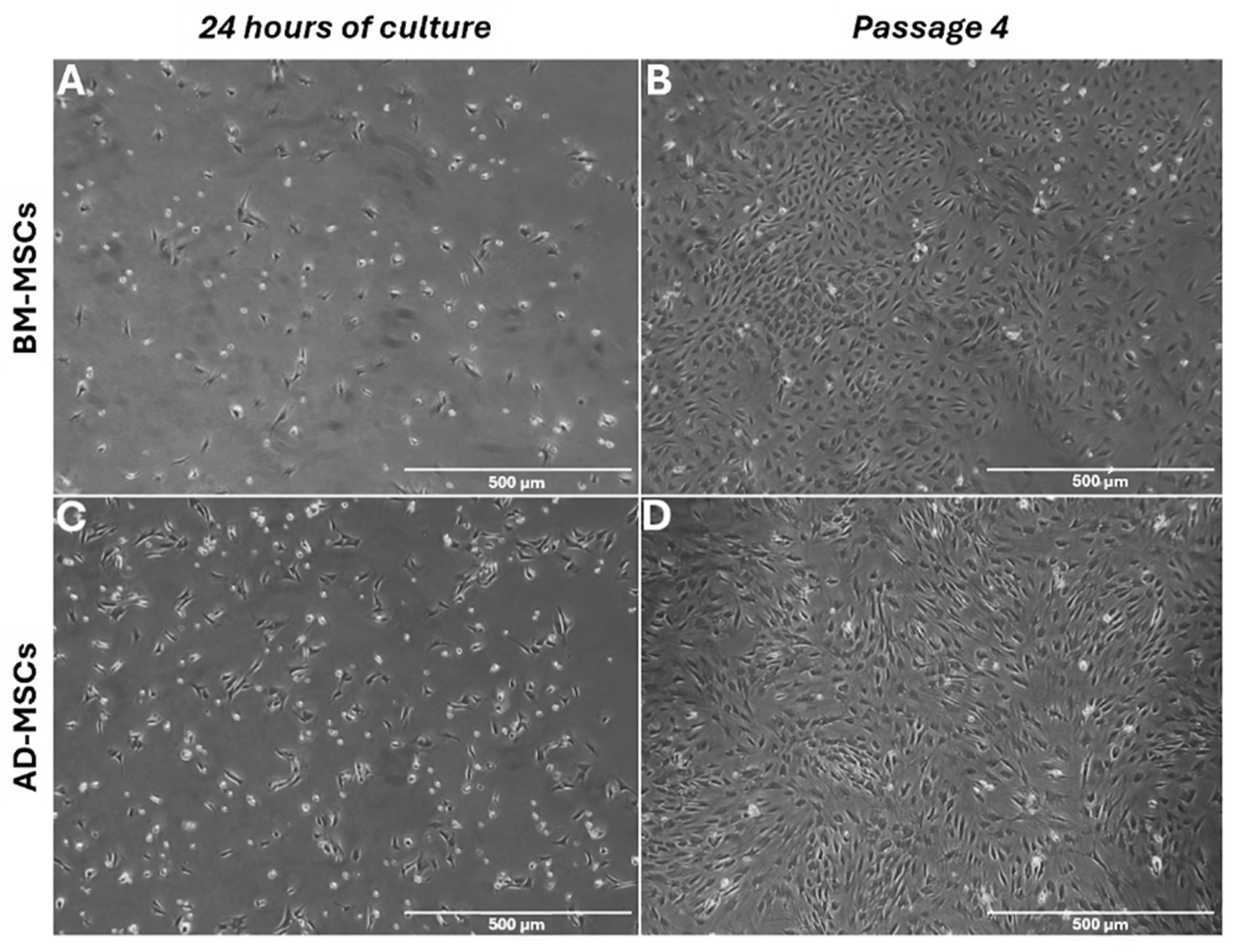

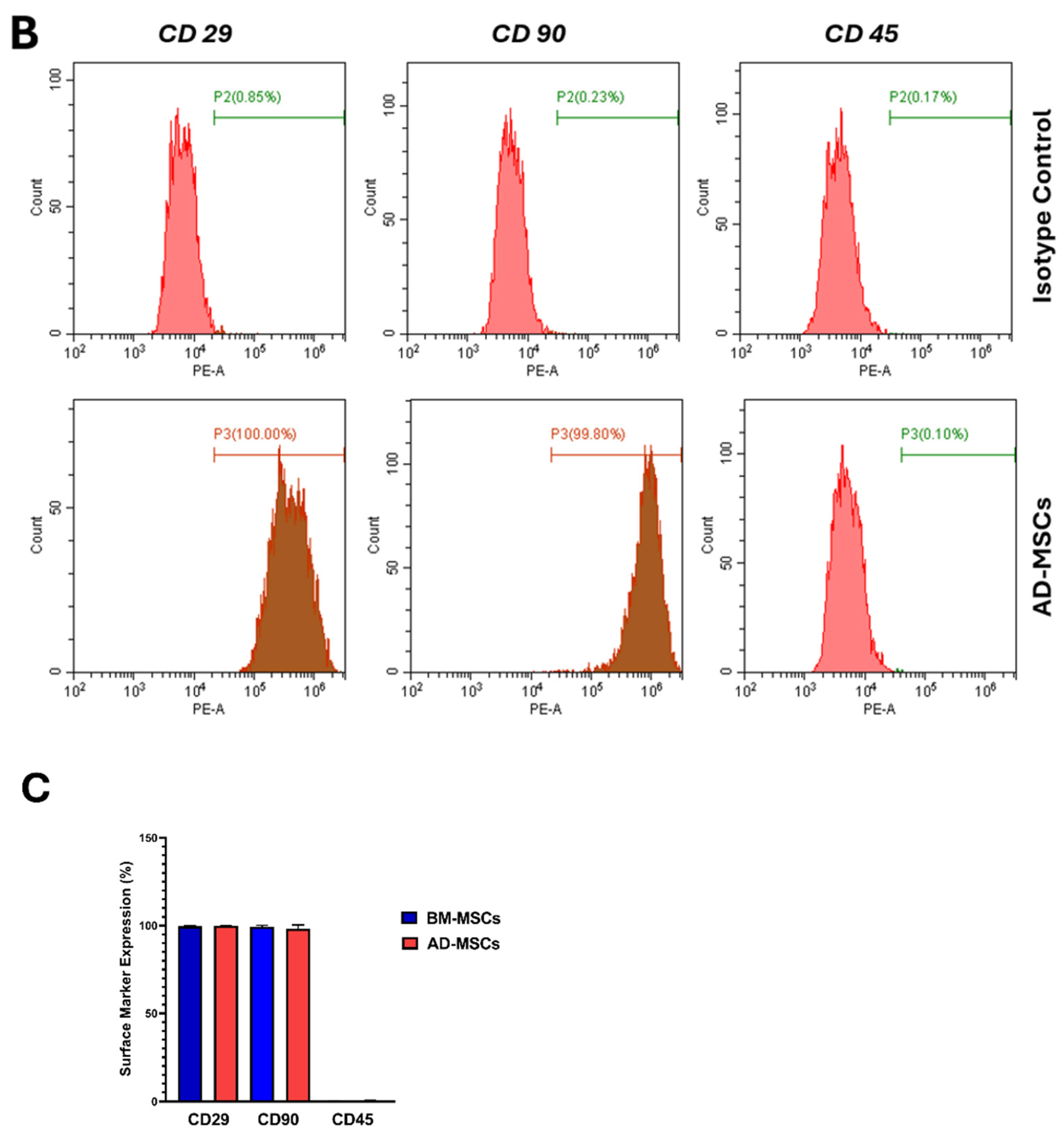
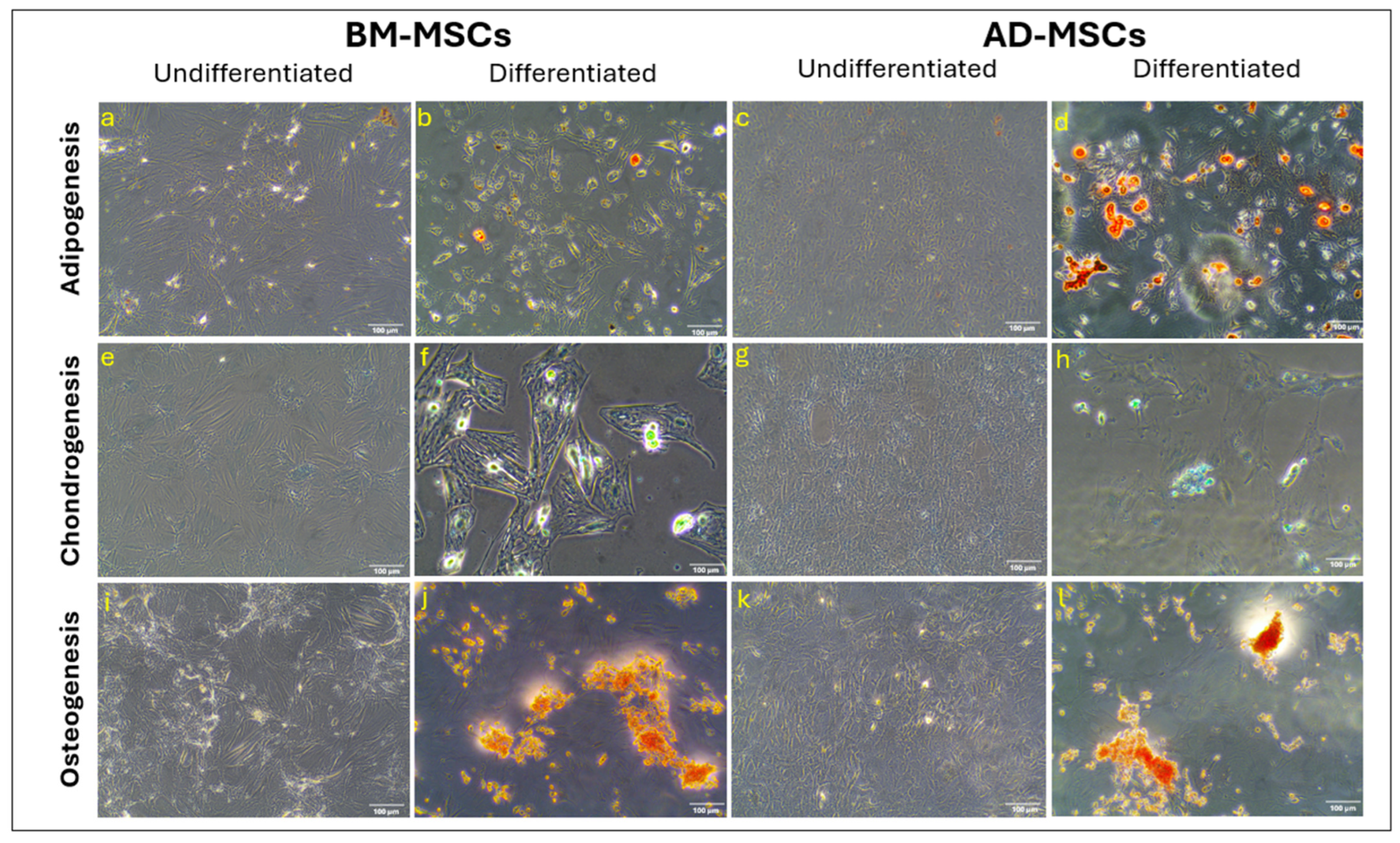



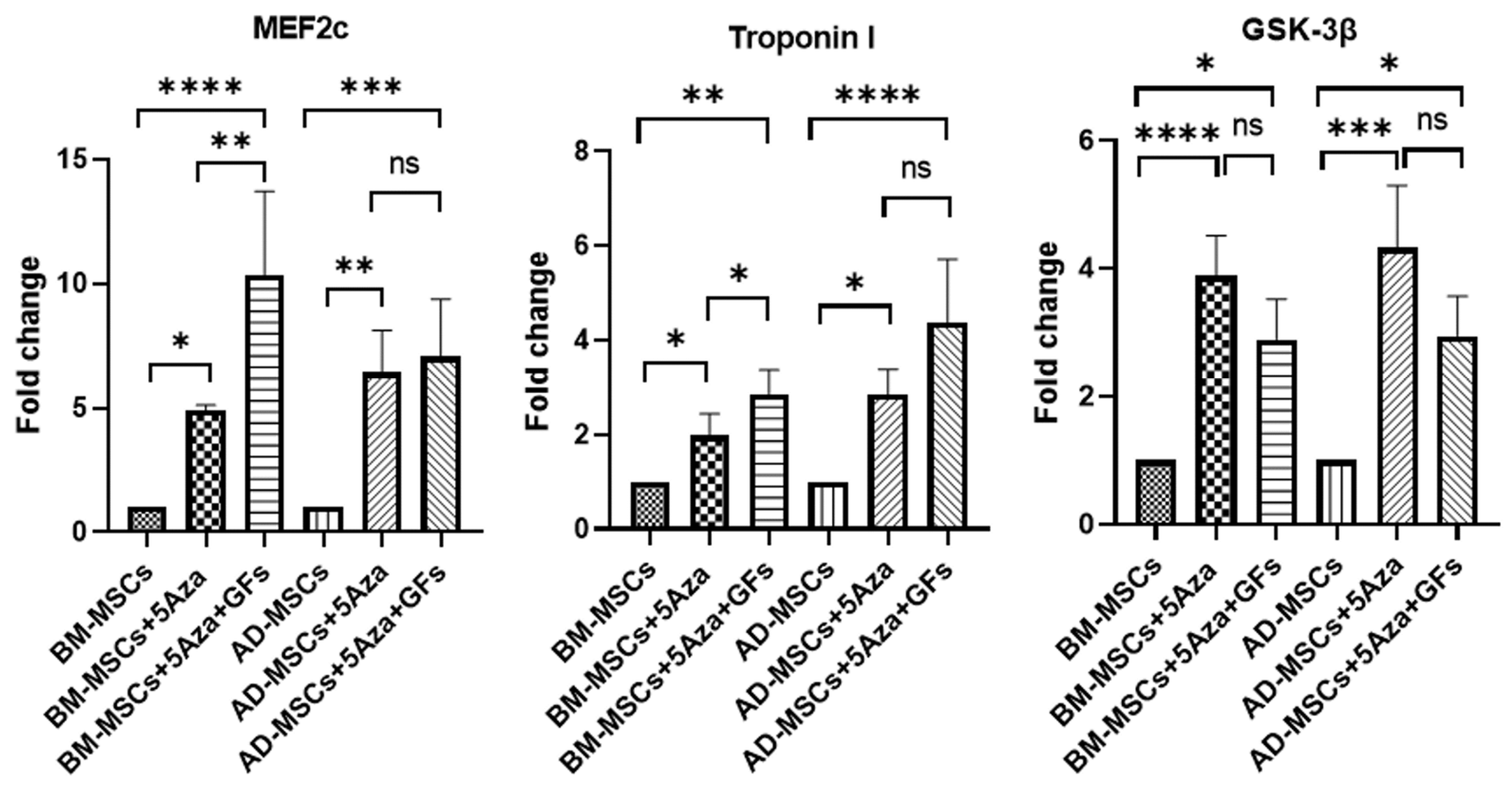
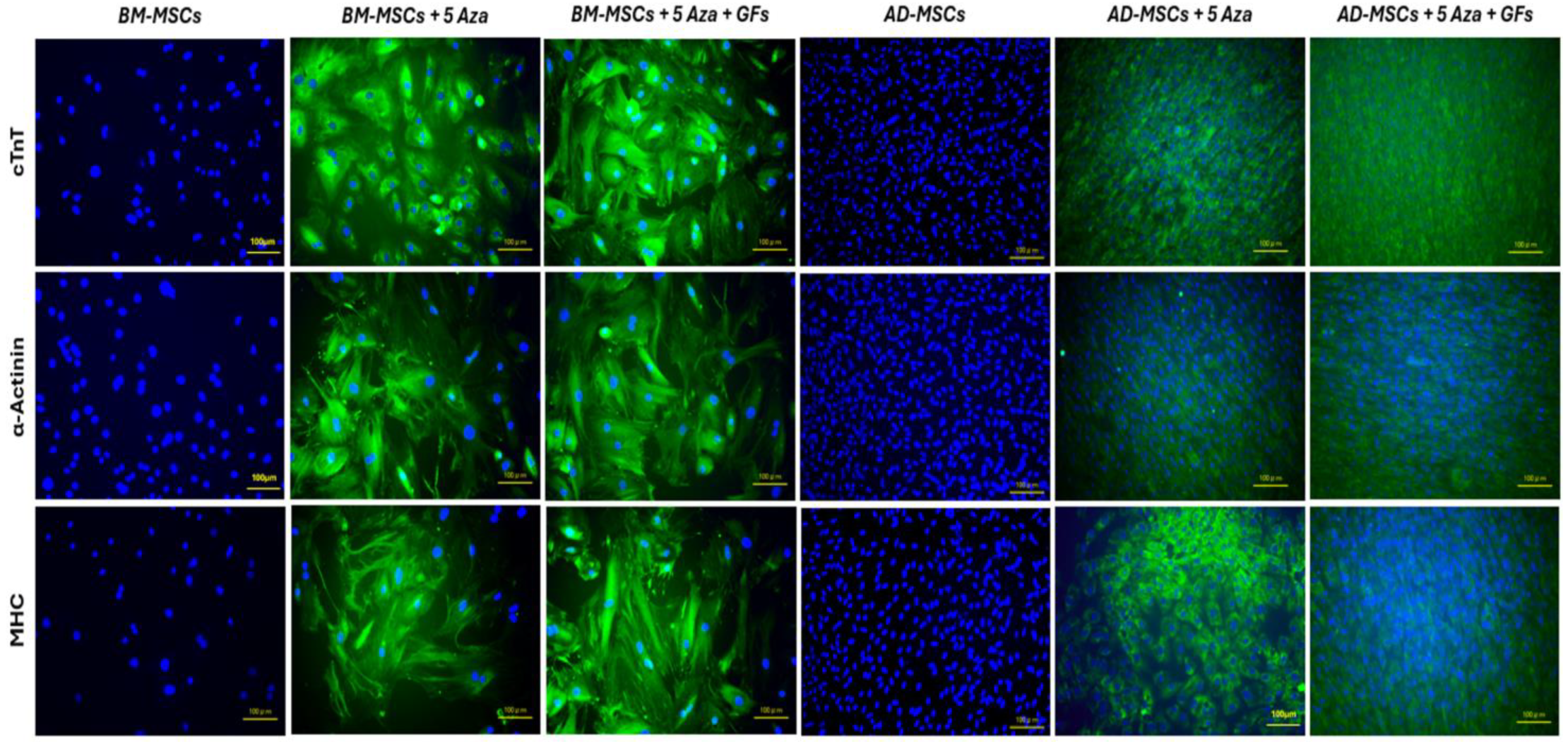
| Purpose | Name | Direction | Primer Sequence |
|---|---|---|---|
| Pluripotent marker genes | NANOG | Forward | TACCTCAGCCTCCAGCAGAT |
| Reverse | CATTGGTTTTTCTGCCACCT | ||
| Oct4 | Forward | CGAACCTGGCTAAGCTTCCA | |
| Reverse | GCCATCCCTCCACAGAACTC | ||
| SOX2 | Forward | CTCGCAGACCTACATGAAC | |
| Reverse | TCGGACTTGACCACAGAG | ||
| REX1 | Forward | GCTCCGGCGGAATCGAGTGG | |
| Reverse | GCACGTGTTGCTTGGCGACC | ||
| Immunomodulatory marker genes | TGFB1 | Forward | ATGCCAACTTCTGTCTGGGG |
| Reverse | GGTTGTAGAGGGCAAGGACC | ||
| IL6 | Forward | CCACCCACAACAGACCAGTA | |
| Reverse | TCTGACAGTGCATCATCGCT | ||
| Housekeeping gene | beta-actin | Forward | CCCATCTATGAGGGTTACGC |
| Reverse | TTTAATGTCACGCACGATTTC |
| Name | Direction | Primer Sequences (5′–3′) |
|---|---|---|
| MEF2c | Forward | ATGCGGCTCTCTGAAGGATG |
| Reverse | TAGCACACACACACACTGCA | |
| Troponin I | Forward | GAGCTTCAGGACCTATGCCG |
| Reverse | GAGAGTGGGCCGCTTAAACT | |
| GSK-3β | Forward | GGATGATGGCCGAGACTCTG |
| Reverse | AGGCTCCCTCCAAGATCCAT | |
| Beta-actin | Forward | CCCATCTATGAGGGTTACGC |
| Reverse | TTTAATGTCACGCACGATTTC |
Disclaimer/Publisher’s Note: The statements, opinions and data contained in all publications are solely those of the individual author(s) and contributor(s) and not of MDPI and/or the editor(s). MDPI and/or the editor(s) disclaim responsibility for any injury to people or property resulting from any ideas, methods, instructions or products referred to in the content. |
© 2024 by the authors. Licensee MDPI, Basel, Switzerland. This article is an open access article distributed under the terms and conditions of the Creative Commons Attribution (CC BY) license (https://creativecommons.org/licenses/by/4.0/).
Share and Cite
Farag, A.; Koung Ngeun, S.; Kaneda, M.; Aboubakr, M.; Tanaka, R. Optimizing Cardiomyocyte Differentiation: Comparative Analysis of Bone Marrow and Adipose-Derived Mesenchymal Stem Cells in Rats Using 5-Azacytidine and Low-Dose FGF and IGF Treatment. Biomedicines 2024, 12, 1923. https://doi.org/10.3390/biomedicines12081923
Farag A, Koung Ngeun S, Kaneda M, Aboubakr M, Tanaka R. Optimizing Cardiomyocyte Differentiation: Comparative Analysis of Bone Marrow and Adipose-Derived Mesenchymal Stem Cells in Rats Using 5-Azacytidine and Low-Dose FGF and IGF Treatment. Biomedicines. 2024; 12(8):1923. https://doi.org/10.3390/biomedicines12081923
Chicago/Turabian StyleFarag, Ahmed, Sai Koung Ngeun, Masahiro Kaneda, Mohamed Aboubakr, and Ryou Tanaka. 2024. "Optimizing Cardiomyocyte Differentiation: Comparative Analysis of Bone Marrow and Adipose-Derived Mesenchymal Stem Cells in Rats Using 5-Azacytidine and Low-Dose FGF and IGF Treatment" Biomedicines 12, no. 8: 1923. https://doi.org/10.3390/biomedicines12081923






